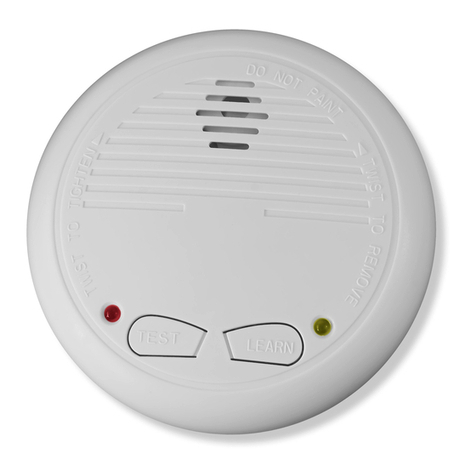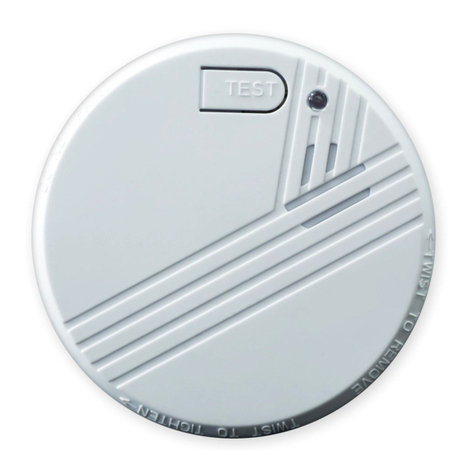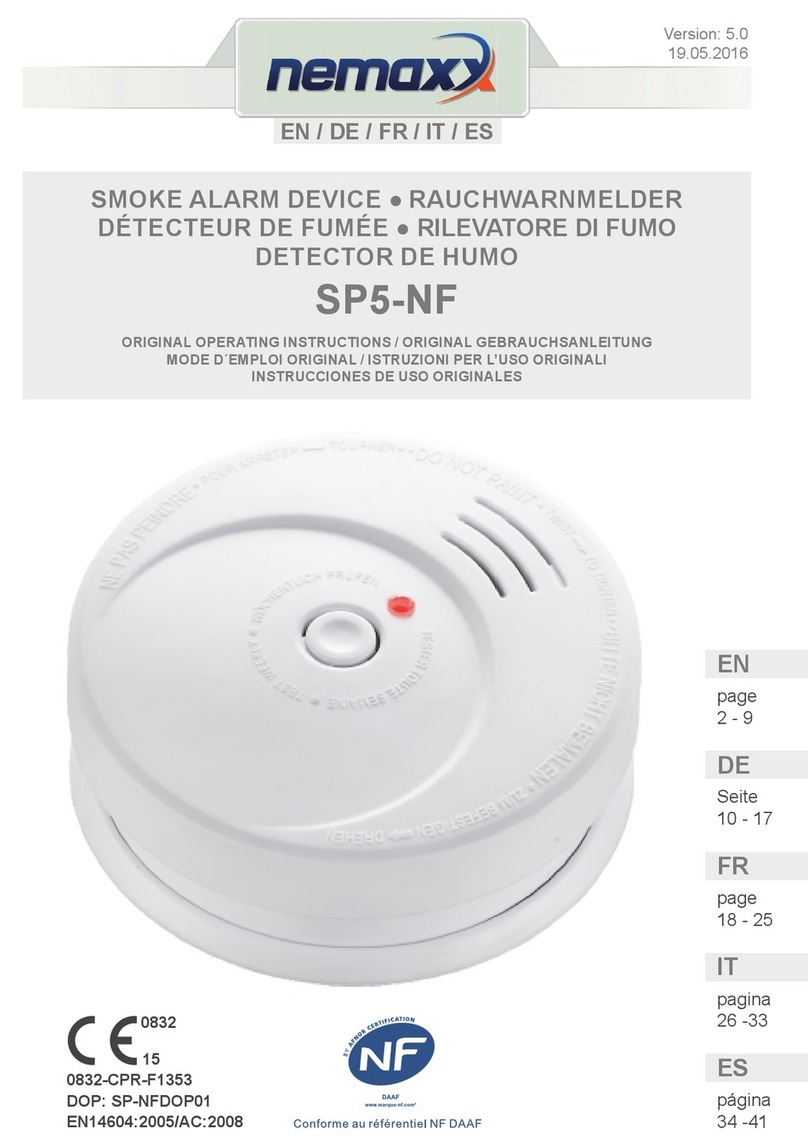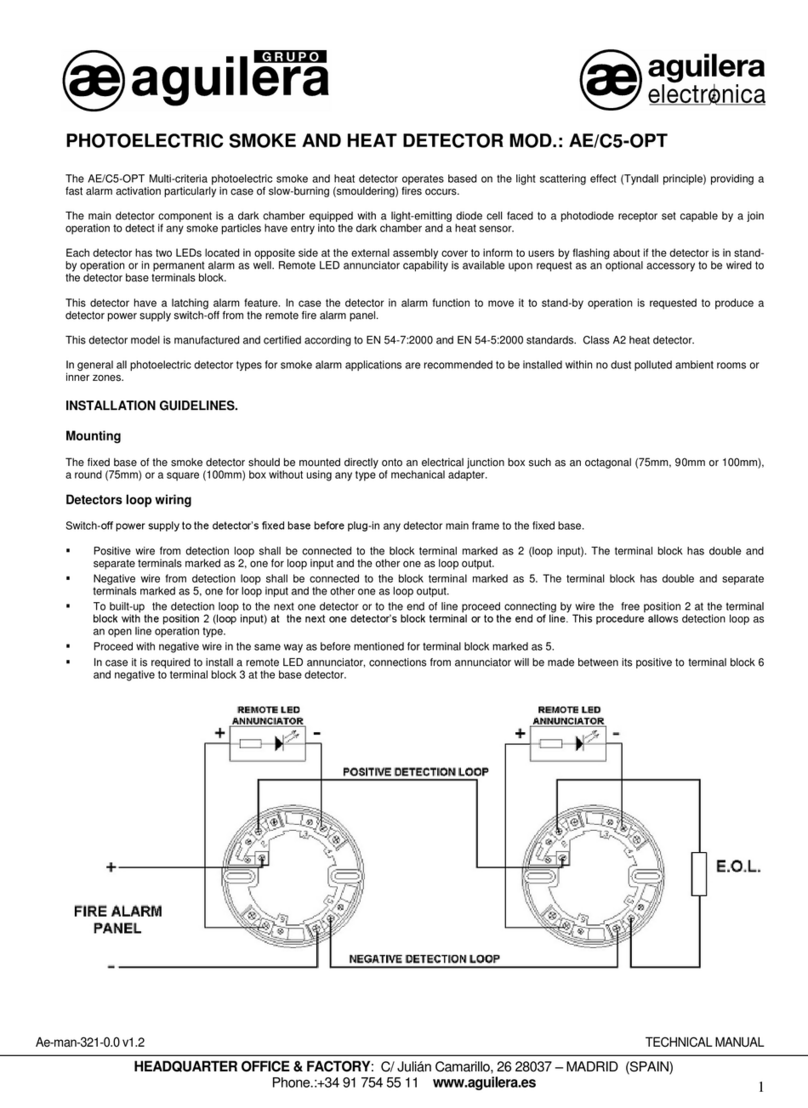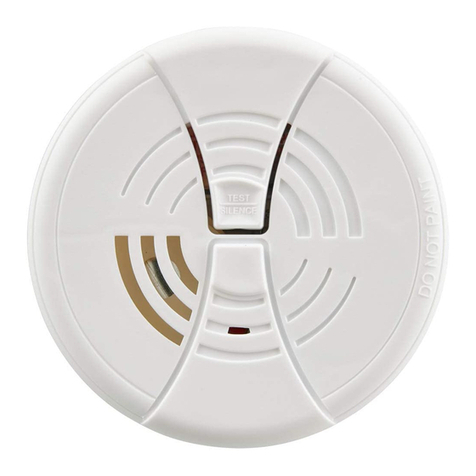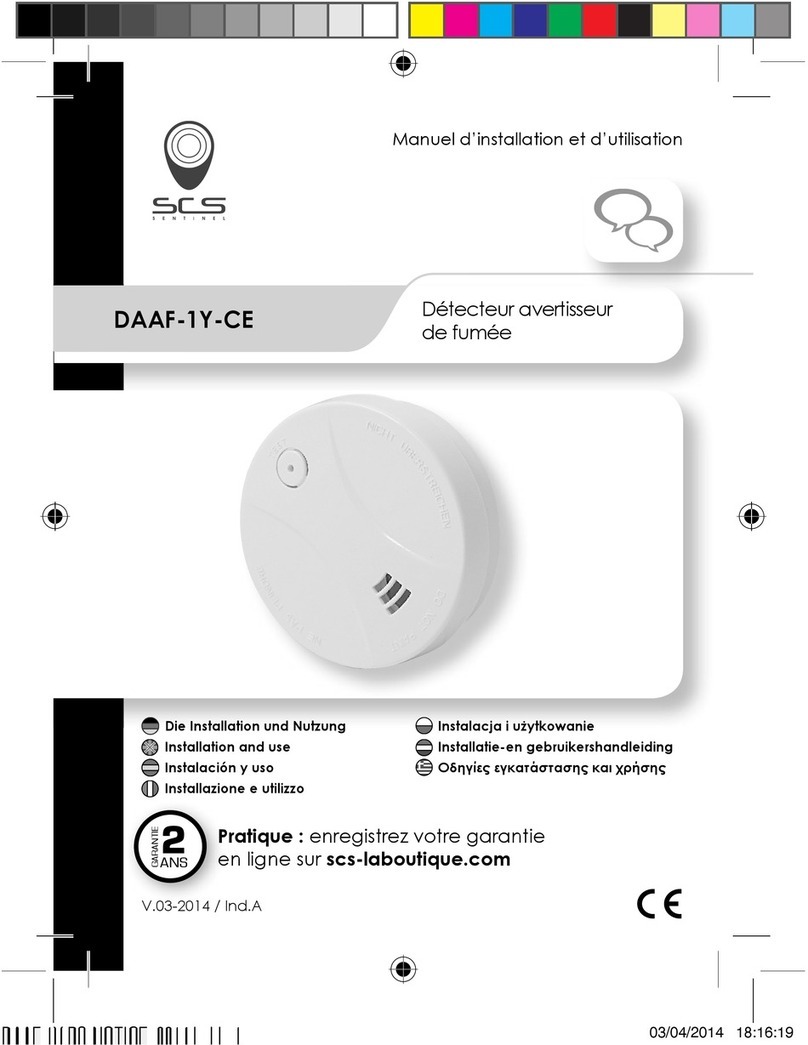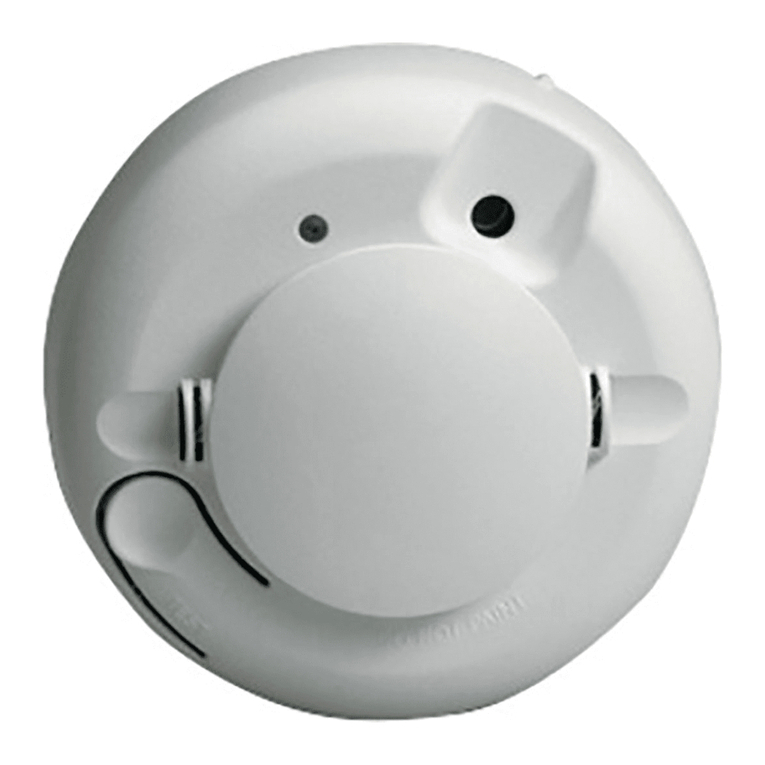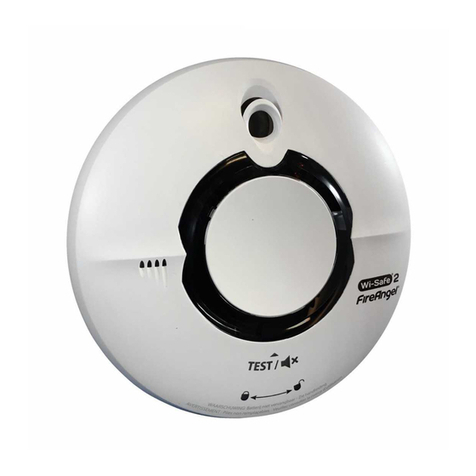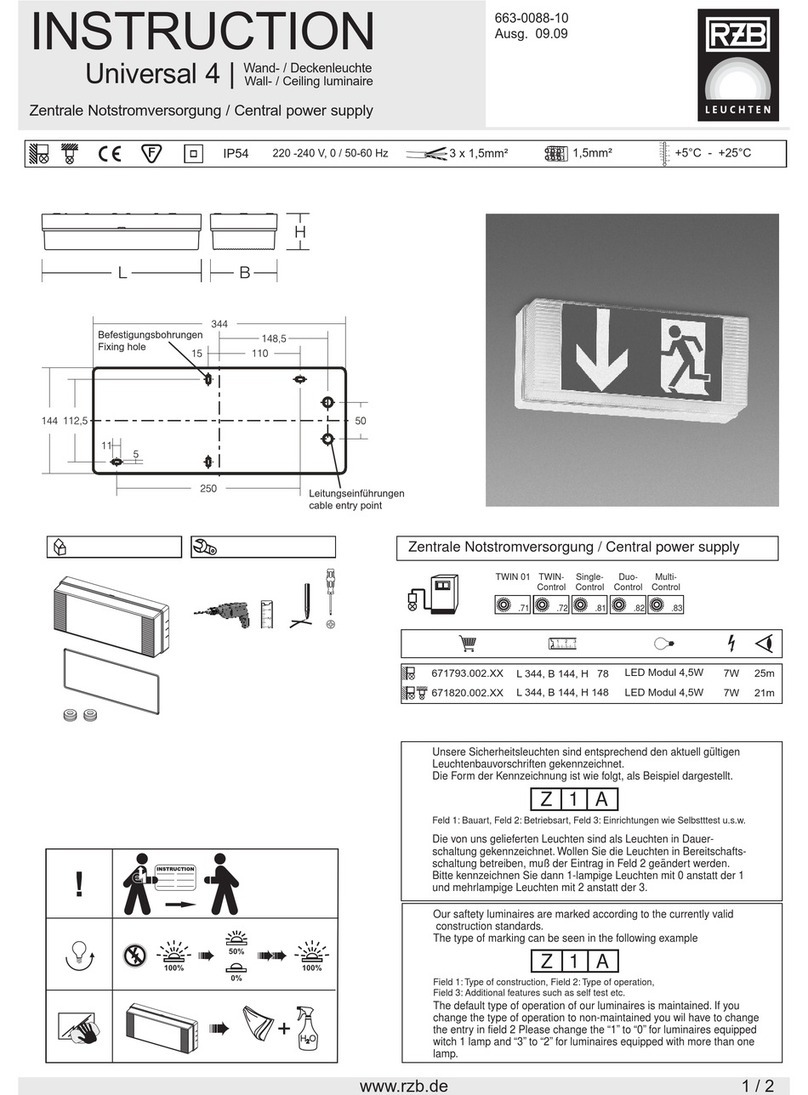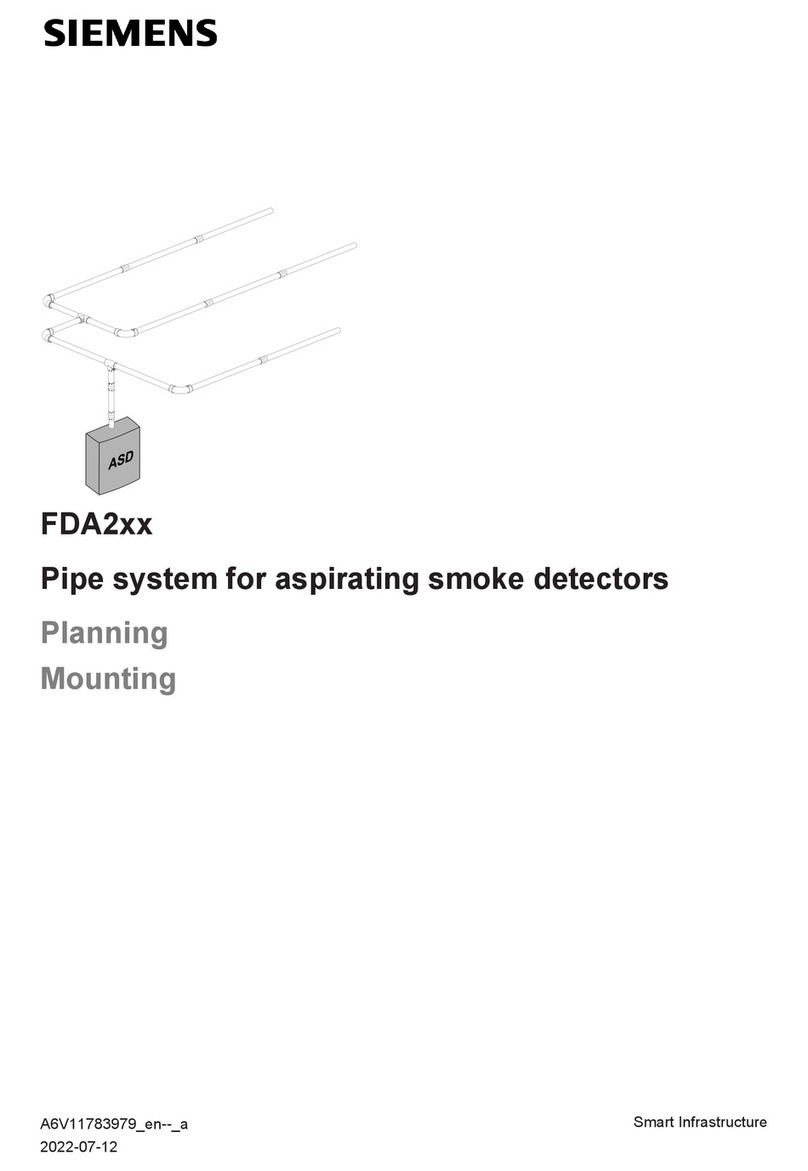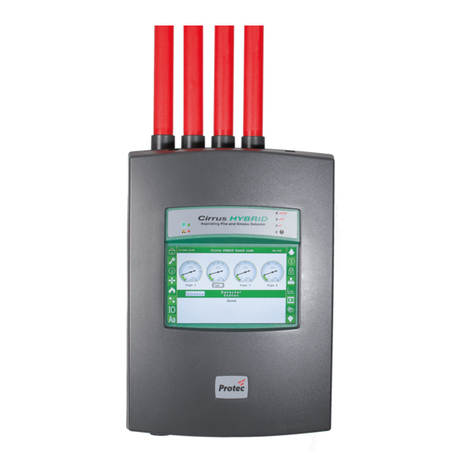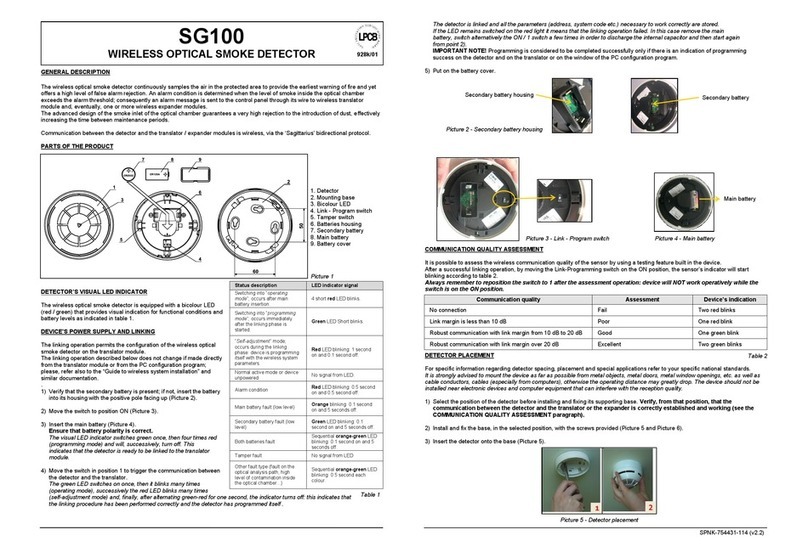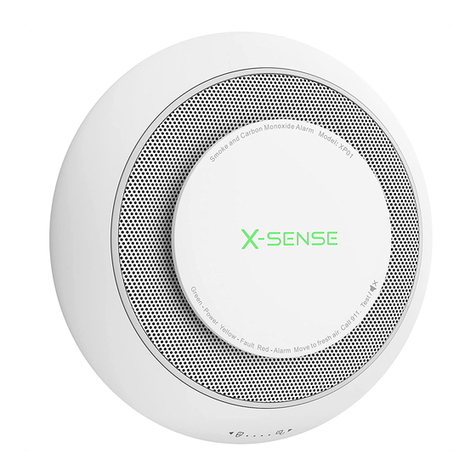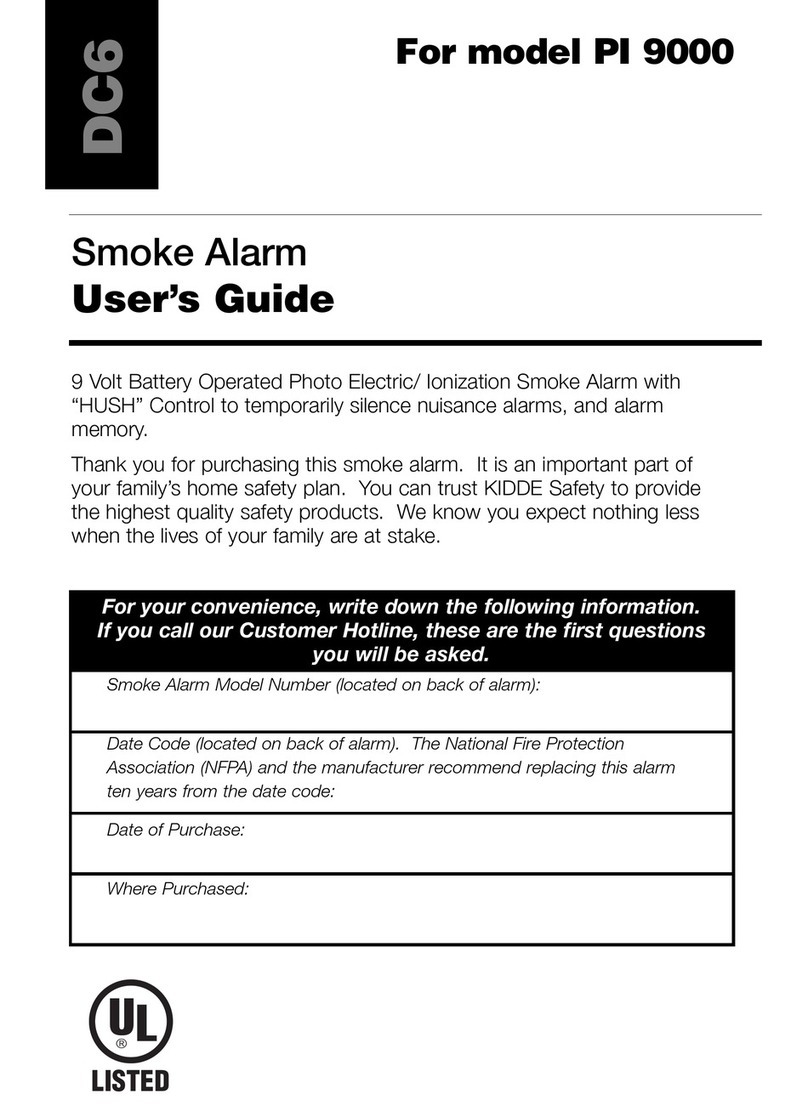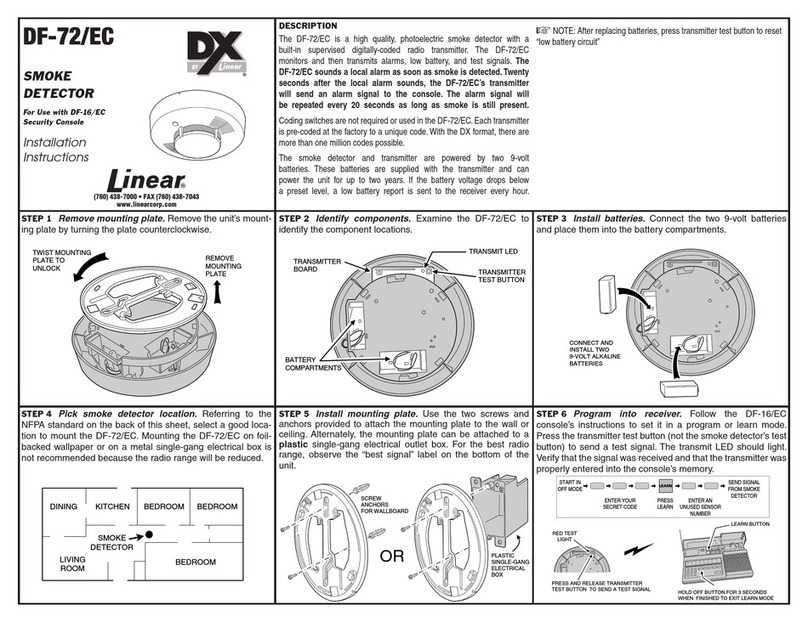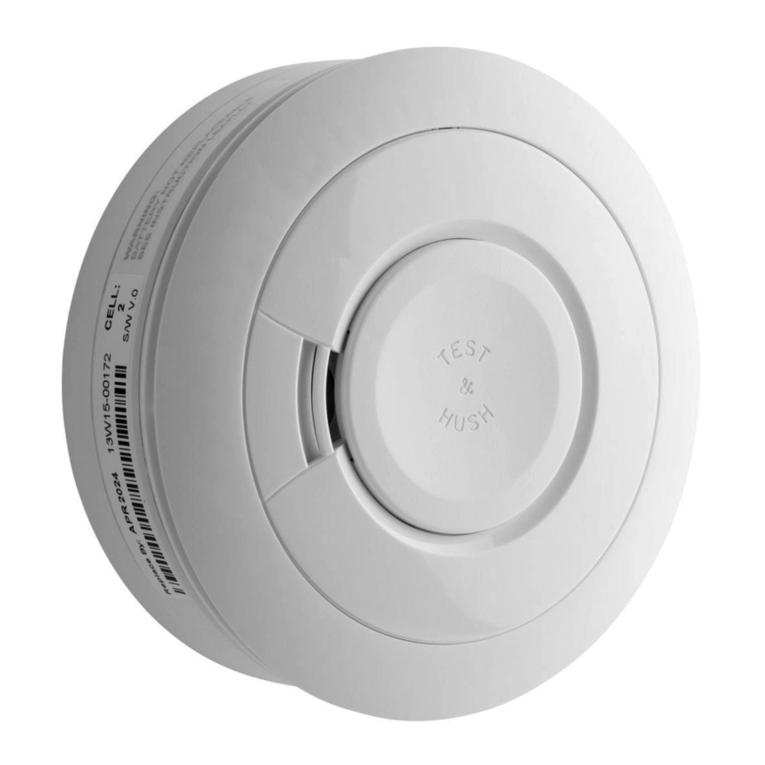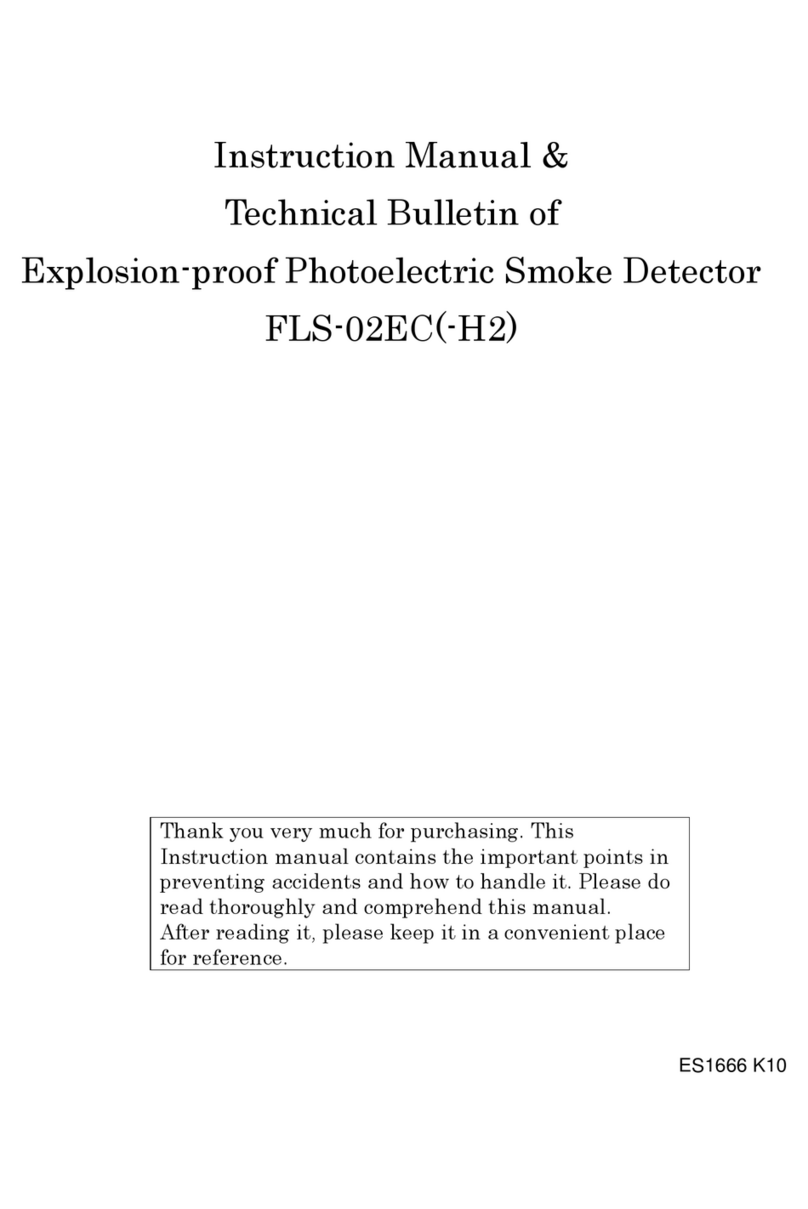Nemaxx FL10-VdS User manual

Version: 2.0
14.07.2016
EN / DE / FR / IT / ES
SMOKE ALARM DEVICE ●RAUCHWARNMELDER
DÉTECTEUR DE FUMÉE ● RILEVATORE DI FUMO
DETECTOR DE HUMO
FL10-VdS
ORIGINAL OPERATING INSTRUCTIONS / ORIGINAL GEBRAUCHSANLEITUNG
MODE D´EMPLOI ORIGINAL / ISTRUZIONI PER L’USO ORIGINALI
INSTRUCCIONES DE USO ORIGINALES
EN
page
2 - 15
DE
Seite
16 - 29
page
30 - 43
FR
pagina
44 - 57
IT
página
58 - 71
ES
0786-CPR-21513
DOP: FL10VdSM01
EN14604:2005/AC:2008
16
0786
G216074

2
Version: 2.0
14.07.2016
EN
DESCRIPTION
The unit is a photoelectric smoke alarm device.
With the photoelectric technology, it is more sensitive to detecting slow smolder res which
general thick, black smoke, a little heat and may smolder for hours before bursting into ames.
The smoke alarm device does not contain the radioactive material which is harmless to the
environment.
The smoke alarm device should be installed in every room (except the bathroom and
kitchen), and every other area of the home, making sure the people in the home will be
able to hear and respond to the alarm sound.
For minimum protection, you should t an alarm respectively for the hallways, living room,
bedrooms and child rooms, each unit shall be placed in the middle of the ceiling of each
room to protect.
Typical single storey dwelling with recommended:
Install a smoke alarm device on the ceiling or wall inside each bedroom and in the hallway
outside each separate sleeping area.
If a bedroom area hallway is more than 30 feet long, install a smoke alarm device at each end.
If there is a basement: install a smoke alarm device on the basement ceiling at the bottom
of the stairwell.
Typical multi-storey dwelling with recommended protection:
Install a smoke alarm device on the ceiling or wall inside each bedroom and in the hallway
outside each separate sleeping area.
If a bedroom area hallway is more than 30 feet long, install a smoke alarm device at each
end install a smoke alarm device at the top of a rst – to- second oor stairwell.
PRODUCT SPECIFICATIONS
• POWER: built-in DC3V (CR123A) Lithium battery
(battery not replaceable)
• OPERATION CURRENT: <8uA (standby), <70mA (alarm)
• ALARM VOLUME: >85dB(A) at 3 meters.
• ALARM SENSITIVITY: 0.11-0.16dB/m
• SILENCE TIME: approx. 10 minutes
• SMOKE ALARM DEVICE SOUND PATTERN:
BI 0.5s - pause 0.5s – BI 0.5s – pause 0.5s – BI 0.5s – pause 1.5s,
with the red LED ash, repeat this alarm pattern.
• COMPLY WITH: EN14604:2005/AC-2008
Thank you for purchasing our smoke alarm device.
Please take a few minutes to read the user’s manual thoroughly and familiarize yourself and your
family with its operation.
And save it for future reference.

3
Version: 2.0
14.07.2016
EN
IMPORTANT SAFETY INFORMATION
1. The test button accurately tests smoke alarm device functions.
Do not use any other test method.
Test smoke alarm device weekly to ensure proper operation.
2. If you‘re sure it isn‘t a really alarm, open windows or fan the air around smoke alarm
device for silence it
3. This smoke alarm device should be installed only by a licensed, qualied electrician.
Observe and follow all local and national electrical and building codes for installation.
4. This smoke alarm device is designed to be used inside a single family only.
In multifamily buildings, each individual living unit should have its own smoke alarm
devices. Do not install in non-residential buildings.
And this smoke alarm device is not a substitute for a complete alarm system.
5. Install a smoke alarm device in every room and on every level of the home.
Smoke may not reach the smoke alarm device for many reasons.
For example, if a re starts in a remote part of the home, on another level, in a chimney,
wall, roof, or on the other side of a closed door, smoke may not reach the smoke alarm
device in time to alert household members.
A smoke alarm device will not promptly detect a re except in the area or room in which
it is installed.
6. Smoke alarm device may not alert every household member every time.
The alarm horn is loud in order to alert individuals to a potential danger.
However, there may be some circumstances where a household member may not hear
the alarm (i.e. outdoor or indoor noise, sound sleepers, drug or alcohol usage, the hard
of hearing, etc.).
If you suspect that this smoke alarm device may not alert a household member, install
and maintain specialty smoke alarm devices. Household member must hear the alarm’s
warning sound and quickly respond to it to reduce the risk of damage, injury, or death
that may result from re.
If a household member is hard of hearing, install special smoke alarm devices with lights
or vibrating devices to alert occupants.
7. Smoke alarm devices can only sound their alarms when they detect smoke or detect
combustion particles in the air. They do not sense heat, ame, or gas. This smoke alarm
device is designed to give audible warning of a developing re.
However, many res are fast - burning, explosive, or intentional, and others are caused
by carelessness or safety hazards. In this circs, Smoke may not remake the unit alarm
QUICKLY ENOUGH to ensure safe escape.
8. Smoke alarm devices have limitations. This smoke alarm device is not foolproof and is
not warranted to protect lives or property from re.
Smoke alarm devices are not a substitute for insurance. Homeowners and renters
should insure their lives and property.
In addition, it is possible for the smoke alarm device to fail at any time. For this reason,
you must test the smoke alarm device weekly and replace unit every 10 years.

4
Version: 2.0
14.07.2016
EN
DO NOT INSTALL SMOKE ALARM DEVICES IN THE FOLLOWING PLACES
1 Near appliances or areas where normal combustion
Regularly occurs (kitchens, near furnaces, hot water heaters).
Use specialized smoke alarm device with unwanted alarm control for this areas.
2: In areas with high humidity, like bathrooms or areas near dishwashers or washing machines.
Install al least 10feet away from these areas.
3. Near air returns or heating and cooling supply vents.
Install at least 3 feet away from these areas.
The air could blow smoke away from the detector, interrupting its alarm.
4. In rooms where temperatures may fall below 0° or rise above 40°, or in humidity higher
than 93%. These conditions will reduce battery life or cause a fault alarm.
5. In extremely dusty, dirty, or insect – infested areas inuence particles interfere with
smoke alarm device operation.
WARNING
The battery is sealed in cover and not replaceable.
Please replace another new alarm if the low battery chirp occurs.
CAUTION
Do not attempt to repair the alarm. It will aect your warranty.
IMPORTANT
Do not attempt to remove the cover to clean inside. This will aect warranty.
MAINTENANCE AND CLEANING
In addition to weekly testing, the alarm requires periodic cleaning to remove dust, dirt, and
debris
Clean the alarm at least once a month to remove dust, dirt, or debris.
Use a vacuum cleaner with the soft brush, vacuum all sides and covers of smoke alarm
device.
This alarm has a low battery monitor which will cause the alarm to “chirp” approx every
40 seconds and the red LED ash once at the same time for a minimum of thirty days
when the battery gets low.
If there is a defective battery or other failures, you can refer to “Trouble shooting” for
solution, if there are still failures during warranty, you can return to your retailer.
REPAIR
If the alarm is not operating properly, and is still under warranty, return it to the original place
you buy. Pack it in a well-padded carton, and ship to the original place you buy.
If the alarm is no longer under warranty, have a licensed electrician replace it immediately with
a comparable alarm.

5
Version: 2.0
14.07.2016
OPERATION
Testing
Test the unit to ensure proper operation by pressing the test button, this will sound the alarm if
the electronic circuitry, horn, and battery are working.
If no alarm sounds, there is a defective battery or other failure, you can refer to
“Trouble shooting” section for solution.
DO NOT use an open ame to test your alarm, you could
damage the alarm or ignite combustible materials and start a re.
LED indicators
Red LED-Flashing once every 40 seconds: indicates that the smoke alarm device is
operating properly
Red LED-Flashing:
When the test button is pressed, or when the smoke alarm device sense particles of
combustion and goes into alarm (constant pulsating sound), the red LED will ash once per
second.
The ashing LED and pulsating alarm will continue until the air is cleared or release test
button.
Red LED-Alarm silencer (Hush mode) indication: The red LED will ash once every
8 seconds, indicating the smoke alarm device is in the alarm silence (Hush) mode.
Low battery indication:
An intermittent “chirp” with red LED ashes once every 40 seconds: indicates that the
smoke alarm device is low battery, you may press the test button for pause alarm for
10 hours, but it will reset automatically after 10 hours.
Fault indication :
The alarm chirp occurs every 40 seconds.
NOTE:
When the units chirp once every 40 seconds, you can press the test button temporarily for
pausing this warning tone for 10 hours, it can still normally detect smoke during this period,
it only removes nuisance warning tone.
You can refer to “Trouble shooting” for solution, if there are still failures, you MUST replace
it with a new alarm at once or contact you retailer during warranty.
CAUTION
Due to the loudness (85 decibels) of the alarm.
Always stand an arms-length away from the unit when testing.
Test the alarm weekly to ensure proper operation.
Erratic or low sound coming from your alarm may indicate a defective alarm,
you can refer to “Trouble shooting” section for solution.
NOTE: WEEKLY TESTING IS REQUIERED.
EN

6
Version: 2.0
14.07.2016
Alarm silence (silence mode)
During the unit is alarming, you push the test button, it will be paused the unit alarming for
approx 10 minutes.
The red LED will ash once every 8 seconds, it indicates the smoke alarm device is run-
ning into the silence mode.
Smoke alarm devices are designed to minimize nuisance alarms. Combustion particles
from cooking may set o the alarm if the alarm is located close to the cooking area.
Large quantities of combustible particles are generated from spills or when grilling/frying.
Using the fan on a range hood that vents to outside (non-recirculating type) will also help
remove these combustible particles from the kitchen.
The alarm silence (test button) is extremely useful in a kitchen area or other areas prone to
nuisance alarms.
The silence feature is to be used only when a known alarm condition, such as smoke from
cooking activates the alarm.
The smoke alarm device is desensitised by push the alarm silence (silence mode) on the
smoke alarm device cover, the alarm will silence to indicate that the alarm is in a
temporarily desensitised condition.
The smoke alarm device will automatically reset after approximately 10 minutes, if after this
period, particles of combustion are still present, the alarm will sound again.
The alarm silencer (silence mode) can be repeatedly until the air has been cleared of the
condition causing the alarm.
CAUTION
Before using the alarm silence (silence), identify the source of the smoke and be
certain a safe condition exists.
DANGER
If the alarm sounds, and it is not being tested, it means the unit is sensing smoke.
THE SOUND OF THE ALARM REQUIRES YOUR IMMEDIATE ATTENTION AND
ACTION.
EN

7
Version: 2.0
14.07.2016
EN
TROUBLE SHOOTING
Problem Method of disposal
Smoke alarm device does not
sound when tested.
1. Must activate alarm before installation
2. Clean smoke alarm device.
Please refer to the “maintenance and cleaning”
section.
3. if there are still failures during warranty, you can
return to your retailer.
4. if the unit is out of warranty, please replace
another new alarm.
The alarm “chirp” with red LED
ashes once every 40 seconds.
The battery is under low battery status, please
replace the smoke alarm device.
Smoke alarm device chirp occurs
every 40 seconds (alarm goes
into fault mode).
Clean smoke alarm device.
Please refer to the “maintenance and cleaning”
section. Purchase and change another smoke alarm
device if the problem still exist
Smoke alarm device sounds
unwanted alarms intermittently
or when residents are cooking,
taking showers, etc
1. Press test button to pause alarm.
2. Clean smoke alarm device.
Please refer to the “maintenance and cleaning”
section.
3. Move smoke alarm device to new location and
press test button.
The alarm sounds dierent from
it is used to.
It starts and stops.
1. Clean smoke alarm device. Please refer to the
“maintenance and cleaning” section.
2. if there are still failures during warranty, you can
return to your retailer.
3. if the unit is out of warranty, please replace
another new alarm.

8
Version: 2.0
14.07.2016
EN
PRACTICE FIRE SAFETY
If the alarm sounds, and you have not pushed the test button, it is warning of a dangerous
situation, your immediate response is necessary.
To prepare for such occurrences, develop family escape plans, discuss them with all
household members, and practice them regularly.
1. Expose everyone to the sound of a smoke alarm device and explain what the sound
means.
2. Determine two exits from each room and an escape route to the outside from each exit.
3. Teach all household members to touch the door and use an alternate exit when the door
is hot, instruct them not to open the door if the door is hot.
4. Teach household members to crawl along the oor to stay below dangerous smoke,
fumes and gases.
5. Determine a safe meeting place for all members outside the building.
WHAT TO DO IN CASE OF FIRE
1. Do not be panic; stay calm.
2. Leave the building as quickly as possible. Touch doors to feel if they were hot before
opening them.
Use an alternate exit if necessary. Crawl along the oor, and do stop to collect anything.
3. Meet at a pre-arranged meeting place outside the building.
4. Call the re department form outside the building.
5. Do not go back inside a burning building. Wait for the re department to arrive.
NOTE
These guidelines will assist you in the event of a re, however, to reduce the
chance that res will start, practice re safety rules and prevent hazardous
situations.

9
Version: 2.0
14.07.2016
EN
WHERE IS THE BEST TO BE INSTALLED
• At rst you need install an alarm in the bedroom and route way, In the case of several
bedrooms, you shall install an alarm in every bedroom.
• Install it in the stairway and in every oor.
• Smoke, heat and burning things will spread horizontally after rising to the ceiling,
so install the alarm on middle of the ceiling of ordinary structure house.
Let the alarm induce every corner.
• If alarm couldn’t be installed in the middle of the ceiling for some reasons, the distance
which the alarm away form the wall corner should be beyond 50cm.
• If installed the alarm on the wall, it should be 10cm below the ceiling (see the diagram 2).
• If the length of the room or the hall is beyond 30 foot, you need install several alarms in
the hall.
• When the wall or ceiling is slanting, the alarm needs to be installed minimum 500mm
away from the highest wall or ceiling point in the room (see the diagram 3).
Diagram 3
Diagram 2

10
Version: 2.0
14.07.2016
EN
INSTALLATION
• Turn the alarm body counterclockwise and take o the bracket.
• Press the bracket on the installation position, mark installation hole of the bracket with
pencil.
• Bore two installation holes on the sign with electric drill. Make diameter of holes is 5mm,
Strike the two plastic plugs into holes with hammer.
• Remove xing plug from the bracket with screwdriver if necessary (Refer to Diagram 4).
• Attach the bracket to the plastic plugs and x tightly the screws into the plastic plugs.
(Refer to Diagram 5).
• Fit the alarm on the bracket and turn the alarm body clockwise, until matching well on
the bracket.
• Insert xing plug to the gap between bracket and bottom cover for xing alarm if you
want(Refer to Diagram 6).
• Press the button for test the unit. The alarm sounds 3 beeps – 1.5 seconds pause,
repeat it until release the button, if no sound, it indicates a defective alarm,
you can refer to ”Trouble shooting” for solution or return to your retailer during warranty.
• If you have any questions on installation, you can contact your retailer.
CAUTION
MUST activate alarm rst, or else there is no function for this unit.
Activation
Press test button and hold it for above 3 seconds until LED lights, and release it
within 2 seconds, the unit will generate a “beep” indicates that it is activated and
goes into work status
WARNING
To prevent injury, this unit must be securely attached to the wall or ceiling in
accordance with the installation instructions.

11
Version: 2.0
14.07.2016
EN
Diagram 5
Diagram 6Diagram 4

12
Version: 2.0
14.07.2016
EN
>Zd/KEK&WZ&KZDE
ĐĐŽƌĚŝŶŐƚŽŶŶĞdž///ŽĨƚŚĞZĞŐƵůĂƚŝŽŶ;hͿϯϬϱϮϬϭϭ
EΣ&>ϭϬsĚ^DϬϭ
hŶŝƋƵĞŝĚĞŶƚŝĨŝĐĂƚŝŽŶĐŽĚĞŽĨƚŚĞƉƌŽĚƵĐƚƚLJƉĞEĞŵĂdždž&>ϭϬͲǀĚƐ
dLJƉĞďĂƚĐŚŽƌƐĞƌŝĂůŶƵŵďĞƌŽƌĂŶLJŽƚŚĞƌĞůĞŵĞŶƚĂůůŽǁŝŶŐŝĚĞŶƚŝĨŝĐĂƚŝŽŶŽĨƚŚĞĐŽŶƐƚƌƵĐƚŝŽŶƉƌŽĚƵĐƚĂƐ
ƌĞƋƵŝƌĞĚƉƵƌƐƵĂŶƚƚŽƌƚŝĐůĞϭϭ;ϰͿ&>ϭϬsĚ^DϬϭ
/ŶƚĞŶĚĞĚƵƐĞŽƌƵƐĞƐŽĨƚŚĞĐŽŶƐƚƌƵĐƚŝŽŶƉƌŽĚƵĐƚŝŶĂĐĐŽƌĚĂŶĐĞǁŝƚŚƚŚĞĂƉƉůŝĐĂďůĞŚĂƌŵŽŶŝnjĞĚ
ƚĞĐŚŶŝĐĂůƐƉĞĐŝĨŝĐĂƚŝŽŶĂƐĨŽƌĞƐĞĞŶďLJƚŚĞŵĂŶƵĨĂĐƚƵƌĞƌƐŵŽŬĞĂůĂƌŵĚĞǀŝĐĞƐ
EĂŵĞƌĞŐŝƐƚĞƌĞĚƚƌĂĚĞŶĂŵĞŽƌƌĞŐŝƐƚĞƌĞĚƚƌĂĚĞŵĂƌŬĂŶĚĐŽŶƚĂĐƚĂĚĚƌĞƐƐŽĨƚŚĞŵĂŶƵĨĂĐƚƵƌĞƌĂƐ
ƌĞƋƵŝƌĞĚƉƵƌƐƵĂŶƚƚŽƌƚŝĐůĞϭϭ;ϱͿ
ĂƌŐĂŝŶϮϰ'
^ŝŚůĞŐŐƐƚƌϮϯ
ϴϴϯϮtŽůůĞƌĂƵ
^ǁŝƚnjĞƌůĂŶĚ
^LJƐƚĞŵŽƌƐLJƐƚĞŵƐŽĨĂƐƐĞƐƐŵĞŶƚĂŶĚǀĞƌŝĨŝĐĂƚŝŽŶŽĨĐŽŶƐƚĂŶĐLJŽĨƉĞƌĨŽƌŵĂŶĐĞŽĨƚŚĞĐŽŶƐƚƌƵĐƚŝŽŶ
ƉƌŽĚƵĐƚĂƐƐĞƚŽƵƚŝŶŶŶĞdžs^LJƐƚĞŵϭ
tŚĞƌĞĂƉƉůŝĐĂďůĞŶĂŵĞĂŶĚĐŽŶƚĂĐƚĂĚĚƌĞƐƐŽĨƚŚĞĂƵƚŚŽƌŝnjĞĚƌĞƉƌĞƐĞŶƚĂƚŝǀĞǁŚŽƐĞŵĂŶĚĂƚĞĐŽǀĞƌƐ
ƚŚĞƚĂƐŬƐŝŶĂƌƚŝĐĞϭϮ;ϮͿ
ĨƵůĨŝůůŵĞŶƚ'ŵď,
/ŬĂƌƵƐĂůůĞĞϭϱ
ϯϬϭϳϵ,ĂŶŶŽǀĞƌ
'ĞƌŵĂŶLJ
/ŶĐĂƐĞŽĨƚŚĞĚĞĐůĂƌĂƚŝŽŶŽĨƉĞƌĨŽƌŵĂŶĐĞĐŽŶĐĞƌŶŝŶŐĂĐŽŶƐƚƌƵĐƚŝŽŶƉƌŽĚƵĐƚĐŽǀĞƌĞĚďLJĂŚĂƌŵŽŶŝnjĞĚ
ƐƚĂŶĚĂƌĚsĚ^^ĐŚĂĚĞŶƐǀĞƌŚƺƚƵŶŐ'ŵď,EΣϬϳϴϲ
ŚĂƐƉĞƌĨŽƌŵĞĚƚLJƉĞƚĞƐƚŝŶŐŽĨƚŚĞƉƌŽĚƵĐƚŝŶŝƚŝĂůŝŶƐƉĞĐƚŝŽŶŽĨƚŚĞŵĂŶƵĨĂĐƚƵƌŝŶŐƉůĂŶƚĂŶĚŽĨĨĂĐƚŽƌLJ
ƉƌŽĚƵĐƚŝŽŶĐŽŶƚƌŽůǁŝƚŚƚŚĞĐŽŶƚŝŶƵŽƵƐƐƵƌǀĞŝůůĂŶĐĞĂƐƐĞƐƐŵĞŶƚĂŶĚĞǀĂůƵĂƚŝŽŶŽĨĨĂĐƚŽƌLJƉƌŽĚƵĐƚŝŽŶ
ĐŽŶƚƌŽů ƵŶĚĞƌ ƐLJƐƚĞŵϭĂŶĚ ŝƐƐƵĞĚĨŽůůŽǁŝŶŐĐĞƌƚŝĨŝĐĂƚĞŽĨ ĐŽŶƐƚĂŶĐLJŽĨ ƉĞƌĨŽƌŵĂŶĐĞĐĞƌƚŝĨŝĐĂƚĞŽĨ
ĐŽŶĨŽƌŵŝƚLJϬϳϴϲͲWZͲϮϭϱϭϯ
/ŶĐĂƐĞŽĨƚŚĞĚĞĐůĂƌĂƚŝŽŶŽĨƉĞƌĨŽƌŵĂŶĐĞĐŽŶĐĞƌŶŝŶŐĂĐŽŶƐƚƌƵĐƚŝŽŶƉƌŽĚƵĐƚĨŽƌǁŚŝĐŚĂƵƌŽƉĞĂŶ
dĞĐŚŶŝĐĂůƐƐĞƐƐŵĞŶƚŚĂƐďĞĞŶŝƐƐƵĞĚE

13
Version: 2.0
14.07.2016
EN
ĞĐůĂƌĞĚƉĞƌĨŽƌŵĂŶĐĞ
EϭϰϲϬϰϮϬϬϱϮϬϬϴʹ^ŵŽŬĞĂůĂƌŵĚĞǀŝĐĞƐ

14
Version: 2.0
14.07.2016
EN

15
Version: 2.0
14.07.2016
EN
dŚĞƉĞƌĨŽƌŵĂŶĐĞŽĨƚŚĞƉƌŽĚƵĐƚŝĚĞŶƚŝĨŝĞĚŝŶƉŽŝŶƚƐϭĂŶĚϮŝƐŝŶĐŽŶĨŽƌŵŝƚLJǁŝƚŚƚŚĞĚĞĐůĂƌĞĚ
ƉĞƌĨŽƌŵĂŶĐĞŝŶƉŽŝŶƚϵdŚŝƐĚĞĐůĂƌĂƚŝŽŶŽĨƉĞƌĨŽƌŵĂŶĐĞŝƐŝƐƐƵĞĚƵŶĚĞƌƚŚĞƐŽůĞƌĞƐƉŽŶƐŝďŝůŝƚLJŽĨƚŚĞ
ŵĂŶƵĨĂĐƚƵƌĞƌŝĚĞŶƚŝĨŝĞĚŝŶƉŽŝŶƚϰ
^ŝŐŶĞĚĨŽƌĂŶĚďĞŚĂůĨŽĨ
EĂŵĞDĂdžŝŵŝůŝĂŶ&ƌŝĞĚĞƌLJ
ŝƌĞĐƚŽƌŽĨĂƌŐĂŝŶϮϰ'
ĂƚĞϮϴϭϬϮϬϭϲ
^ŝŐŶĂƚƵƌĞ

16
Version: 2.0
14.07.2016
DE
PRODUKTBESCHREIBUNG
Dieses Gerät ist ein photoelektrischer Rauchwarnmelder. Die photoelektrische Technologie
ermöglicht eine höhere Empndlichkeit für die Erfassung von langsamen Schwelbränden,
welche im Allgemeinen durch dichten, schwarzen Rauch und niedrige Hitze gekennzeichnet
sind und stundenlang schwelen können, bevor sich Flammen bilden.
Der Rauchwarnmelder enthält kein radioaktives Material und ist unschädlich für die Umwelt.
Der Rauchwarnmelder sollte in jedem Zimmer (außer in Bad und Küche) und in jedem
anderen Wohnbereich montiert werden, sodass alle Personen im Haus das Alarmsignal
hören und darauf reagieren können. Für einen Mindestschutz sollten Sie Flure, Wohnzimmer,
Schlafzimmer und Kinderzimmer jeweils mit einem Rauchwarnmelder ausstatten.
Jedes Gerät sollte zum Schutz jedes Raumes vorzugsweise in der Mitte der Zimmerdecke
platziert werden. Bitte beachten Sie Abbildungen 2 und 3 für die richtige Platzierung.
Empfohlener Schutz für typische eingeschossige Wohnungen:
Montieren Sie einen Rauchwarnmelder an der Decke oder Wand in jedem Schlafzimmer
und im Flur zu jedem separaten Schlafbereich. Wenn die Länge eines Flurs im
Schlafbereich mehr als 10 Meter beträgt, montieren Sie einen Rauchwarnmelder an jedem
Ende. Falls ein Keller vorhanden ist: Montieren Sie einen Rauchwarnmelder an der
Kellerdecke am unteren Ende des Treppenhauses.
Empfohlener Schutz für mehrstöckige Gebäude:
Montieren Sie einen Rauchwarnmelder an der Decke oder Wand in jedem Schlafzimmer
und im Flur zu jedem separaten Schlafbereich. Wenn die Länge eines Flurs im
Schlafbereich mehr als 10 Meter beträgt, montieren Sie einen Rauchwarnmelder an jedem
Ende. Installieren Sie außerdem einen Rauchwarnmelder am oberen Ende eines
Treppenaufgangs vom ersten zum zweiten Stock.
PRODUKTSPEZIFIKATIONEN
• BATTERIEBETRIEB: fest eingebaute 3V (CR123A) Lithium-Batterie
(Batterie nicht auswechselbar)
• STROMAUFNAHME: <8uA (Standby), <70mA (Alarm)
• ALARM-LAUTSTÄRKE: >85dB(A) innerhalb von 3 Metern
• ALARM-EMPFINDLICHKEIT: 0,11-0,16 dB/m
• STUMMSCHALTUNG: ca. 10 Minuten
• KLANGMUSTER DES RAUCHWARNMELDERS:
BI 0,5s – Pause 0,5s – BI 0,5s – Pause 0,5s – BI 0,5s – Pause 1,5s,
mit rotem LED-Blitz, Wiederholung des Alarmschemas.
• GEPRÜFT NACH: EN14604:2005/AC-2008
Vielen Dank, dass Sie sich für unseren Rauchwarnmelder entschieden haben.
Bitte nehmen Sie sich ein paar Minuten Zeit, um die Bedienungsanleitung sorgfältig zu lesen und
sich und Ihre Familie mit der Bedienung des Gerätes vertraut zu machen.
Heben Sie die Anleitung gut auf, um später auf sie zurückgreifen zu können.

17
Version: 2.0
14.07.2016
DE
WICHTIGE SICHERHEITSINFORMATIONEN
1. Die Prüftaste dient der genauen Überprüfung der Funktionen des Rauchwarnmelders.
Prüfen Sie niemals mit anderen Prüfmethoden. Prüfen Sie den Rauchwarnmelder einmal
wöchentlich, um zu gewährleisten, dass er richtig funktioniert.
2. Wenn Sie sich sicher sind, dass keine wirkliche Alarm-situation vorliegt, önen Sie die
Fenster oder fächern Sie die Luft vom Rauchwarnmelder weg, um ihn stumm zu schalten.
3. Die Montage dieses Rauchwarnmelders sollte von einer zugelassenen und qualizierten
Elektrofachkraft durchgeführt werden. Beachten und befolgen Sie alle lokalen und nationalen
Elektro- und Bauvorschriften für die Installation.
4. Dieser Rauchwarnmelder ist nur für den Einsatz in Wohngebäuden vorgesehen.
In Mehrfamilienhäusern sollte jede einzelne Wohneinheit ihre eigenen Rauchwarnmelder haben.
Montieren Sie den Melder niemals in Gebäuden, die nicht Wohnzwecken dienen.
Weiterhin ist dieser Rauchwarnmelder kein Ersatz für ein komplettes Alarmsystem.
5. Installieren Sie jeweils einen Rauchwarnmelder in jedem Raum und auf jeder Ebene des
Hauses. Rauch könnte aus vielerlei Gründen den Rauchwarnmelder nicht erreichen.
Wenn beispielsweise ein Feuer in einem entfernten Teil des Hauses, auf einer anderen Ebene,
im Kamin-, Wand-, Dachbereich oder auf der anderen Seite einer geschlossenen Tür
ausbricht, kann der Rauch möglicherweise nicht rechtzeitig den Rauchwarnmelder erreichen,
um die Mitglieder des Haushalts zu warnen. Ein Rauchwarnmelder wird ein Feuer in einem
Bereich oder Zimmer nur dann sofort erkennen, wenn er dort installiert ist.
6. Der Rauchwarnmelder kann möglicherweise nicht immer jedes Haushaltsmitglied alarmieren.
Das Alarmsignal ist laut genug, um Personen bei einer möglichen Gefahr zu warnen.
Allerdings kann es zu Situationen kommen, in denen ein Haushaltsmitglied den Alarm nicht
hören kann (z. B. Lärm von innen oder außen, Personen mit einem sehr tiefen Schlaf,
Drogen- oder Alkoholkonsum, eine Hörbehinderung etc.). Wenn Sie vermuten, dass dieser
Rauchwarnmelder ein Haushaltsmitglied möglicherweise nicht aufmerksam machen kann,
installieren Sie spezielle Rauchwarnmelder und setzen diese ein. Jedes Haushaltsmitglied
muss den Warnton des Alarms hören und schnell darauf reagieren können, um das Risiko
von Brandschäden und -verletzungen oder sogar dem Tod zu mindern.
Wenn ein Haushaltsmitglied hörbehindert sein sollte, installieren Sie spezielle
Rauchwarnmelder mit Lichtern oder vibrierende Geräte, um Bewohner zu warnen.
7. Rauchwarnmelder können nur dann einen Alarmton ertönen lassen, wenn sie Rauch
aufspüren oder Verbrennungspartikel in der Luft erkennen. Sie sind nicht zum Aufspüren von
Hitze, Flammen oder Gas geeignet. Dieser Rauchwarnmelder ist dafür vorgesehen, eine
akustische Warnung bei Entwicklung eines Brandes zu geben. Allerdings breiten sich viele
Brände schnell aus, sind explosiv oder werden absichtlich gelegt, andere werden durch
Unachtsamkeit oder Sicherheitsrisiken verursacht. In solchen Fällen erreicht der Rauch
möglicherweise die Rauchwarnmelder nicht SCHNELL GENUG, um ein sicheres Entkommen
zu gewährleisten.
8. Rauchwarnmelder haben ihre Grenzen. Dieser Rauchwarnmelder ist nicht narrensicher und
garantiert keinen Schutz von Leben oder Eigentum vor Feuer. Rauchwarnmelder sind kein
Ersatz für eine Versicherung. Hausbesitzer und Mieter sollten Leben und Eigentum
ausreichend versichern. Darüber hinaus ist es zu jeder Zeit möglich, dass es zu einem
Versagen des Rauchwarnmelders kommt. Aus diesem Grund müssen Sie den
Rauchwarnmelder wöchentlich testen und das Gerät alle 10 Jahre ersetzen.

18
Version: 2.0
14.07.2016
DE
INSTALLIEREN SIE RAUCHWARNMELDER NIEMALS AN DEN FOLGENDEN ORTEN
1. In der Nähe von Geräten oder Bereichen, bei denen eine normale Rauchentwicklung
regelmäßig auftritt (Küchen, Öfen, Warmwasserboilern).
Benutzen Sie für diese Bereiche spezielle Rauchwarnmelder, die das Auslösen eines
unerwünschten Alarms verhindern.
2. In Bereichen mit hoher Luftfeuchtigkeit, wie Badezimmer, oder in Bereichen in der Nähe von
Geschirrspülern oder Waschmaschinen. Halten Sie bei der Installation mindestens 3 Meter
Abstand von diesen Bereichen.
3. In der Nähe von Be- und Entlüftungsschächten oder Önungen für die Wärme- und
Kälteversorgung. Halten Sie bei der Installation mindestens 1 Meter Abstand von diesen
Bereichen. Die Luft könnte den Rauch vom Rauchwarnmelder wegblasen und somit den
Alarm unterbrechen oder verhindern.
4. In Räumen, in denen die Temperaturen unter 0°C fallen oder über 40°C steigen können
oder bei denen die Luftfeuchtigkeit mehr als 93 % beträgt. Diese Bedingungen reduzieren
die Lebensdauer der Batterie oder verursachen einen Fehlalarm.
5. In extrem staubigen, schmutzigen oder von Insekten befallenen Bereichen, da Partikel
Einuss auf den Betrieb des Rauchwarnmelders haben und stören können
BETRIEB
Test
Um einen ordnungsgemäßen Betrieb zu gewährleisten, testen Sie das Gerät durch Drücken
der Prüftaste.
Ein Alarmton ertönt, wenn Elektronik, Alarmsignal und Batterie funktionieren.
Ertönt kein Alarmsignal, könnte dies durch eine defekte Batterie oder eine andere Störung
bedingt sein.
Lesen Sie den Abschnitt „Fehlerbehebung“, um eine Lösung zu nden.
Verwenden Sie NIEMALS eine oene Flamme, um den Alarm zu testen.
Sie könnten den Alarm beschädigen oder brennbare Materialien entzünden und ein Feuer
verursachen.
ACHTUNG
Aufgrund der hohen Lautstärke (85 Dezibel) des Alarms halten Sie beim Testen
immer ca. eine Armlänge Abstand vom Gerät.
Prüfen Sie den Rauchwarnmelder einmal wöchentlich, um einen ordnungsgemäßen
Betrieb zu gewährleisten.
Ein unregelmäßiges oder leises Signal Ihres Rauchwarnmelders kann auf einen
defekten Rauchwarnmelder hinweisen.
Lesen Sie den Abschnitt „Fehlerbehebung“, um eine Lösung zu nden.
HINWEIS: ES IST EINE WÖCHENTLICHE ÜBERPRÜFUNG ERFORDERLICH.

19
Version: 2.0
14.07.2016
LED-Leuchtanzeige
Die rote LED blinkt einmal alle 40 Sekunden: Dies zeigt an, dass der Rauchwarnmelder
ordnungsgemäß funktioniert.
Blinken der roten LED:
Wenn die Prüftaste gedrückt wird oder wenn der Rauchwarnmelder Verbrennungspartikel
wahrnimmt und in den Alarm-Modus wechselt (anhaltender pulsierender Ton), blinkt die rote
LED einmal pro Sekunde.
Die blinkende LED und der pulsierende Alarm dauern an, bis die Luft gereinigt ist oder die
Prüftaste losgelassen wird.
Die rote LED zeigt die Stummschaltfunktion (Hush-Modus) des Rauchwarnmelders an:
Blinkt die rote LED einmal alle 8 Sekunden, wird damit angezeigt, dass sich der
Rauchwarnmelder im Stummschalt-/(Hush)-Modus bendet.
Anzeige einer schwachen Batterie:
Ein „Piep“-Ton mit blinkender roter LED einmal alle 40 Sekunden zeigt an, dass die Batterie
des Rauchwarnmelders schwach ist. Sie können die Prüftaste drücken, um diese Warnung für
10 Stunden zu unterbrechen, aber nach 10 Stunden wird diese automatisch wieder generiert.
Fehleranzeige:
Der Rauchwarnmelder „piept“ alle 40 Sekunden.
HINWEIS:
Wenn der Rauchwarnmelder einmal alle 40 Sekunden piept, können Sie vorübergehend die
Prüftaste betätigen, um diesen Warnton für 10 Stunden zu unterbrechen.
Der Rauchwarnmelder kann in dieser Zeit normalerweise immer noch Rauch erfassen, es
entfällt nur der lästige Warnton.
Lesen sie den Abschnitt „Fehlerbehebung“, falls es dennoch zu Störungen kommen sollte.
Sie MÜSSEN den Rauchwarnmelder unverzüglich durch einen neuen Rauchwarnmelder
ersetzen oder sich innerhalb des Gewährleistungszeitraums mit einem Händler in Verbindung
setzen.
DE

20
Version: 2.0
14.07.2016
Stummschaltung des Alarms (Stummschaltmodus)
Wird ein Fehlalarm ausgelöst, drücken Sie die Prüftaste des Rauchwarnmelders, um das
Alarmsignal für ca. 10 Minuten stumm zu schalten.
Die rote LED wird dann einmal alle 8 Sekunden blinken, um anzuzeigen, dass sich der
Alarm des Rauchwarnmelders im Stummschaltmodus bendet.
Rauchwarnmelder sind so ausgelegt, dass Fehlalarme minimiert werden.
Verbrennungspartikel, die durch Kochen entstehen, können den Alarm auslösen, wenn der
Rauchwarnmelder in der Nähe des Kochbereichs platziert wird.
Große Mengen von brennbaren Partikeln werden durch Verschütten oder beim Grillen/
Braten freigesetzt. Durch Verwendung einer Dunstabzugshaube mit Ablufteinrichtung (kein
Umluft-Typ) können Verbrennungspartikel eektiv aus der Küchenluft entfernt werden.
Die Alarm-Stopp-Funktion (Prüftaste) ist sehr nützlich in der Küche oder in anderen
Bereichen, die anfällig für Fehlalarme sind.
Die Stummschaltfunktion sollte nur dann verwendet werden, wenn der Auslöser für den
Fehlalarm, wie Rauch vom Kochen, bekannt ist.
Durch Drücken der Alarm-Stopp-Taste (Stummschaltmodus) an der Abdeckung des
Rauchwarnmelders wird dieser desensibilisiert.
Das Verstummen des Alarms zeigt an, dass sich der Rauchwarnmelder vorübergehend in
einem desensibilisierten Zustand bendet.
Zusätzlich blinkt die rote LED einmal alle 8 Sekunden.
Der Rauchwarnmelder wird nach ca. 10 Minuten automatisch zurückgesetzt.
Falls nach diesem Zeitraum immer noch Rauchpartikel vorhanden sind, wird der Alarm
erneut ertönen.
Die Stummschaltung des Alarms (Stummschaltmodus) kann wiederholt betätigt werden,
bis die Luft gereinigt und vom Auslöser des Alarms befreit wurde.
ACHTUNG
Bevor Sie die Alarm-Stopp-Funktion aktivieren, klären Sie die Ursache für die
Rauchentwicklung und vergewissern Sie sich, dass keine weitere Gefahr besteht.
GEFAHR
Wenn der Alarm ertönt (und nicht gerade geprüft wird), bedeutet dies,
dass das Gerät Rauch erkennt.
DAS ERTÖNEN DES ALARMS ERFORDERT IHRE SOFORTIGE
AUFMERKSAMKEIT UND DIE ERGREIFUNG VON MASSNAHMEN.
DE
Table of contents
Other Nemaxx Smoke Alarm manuals

